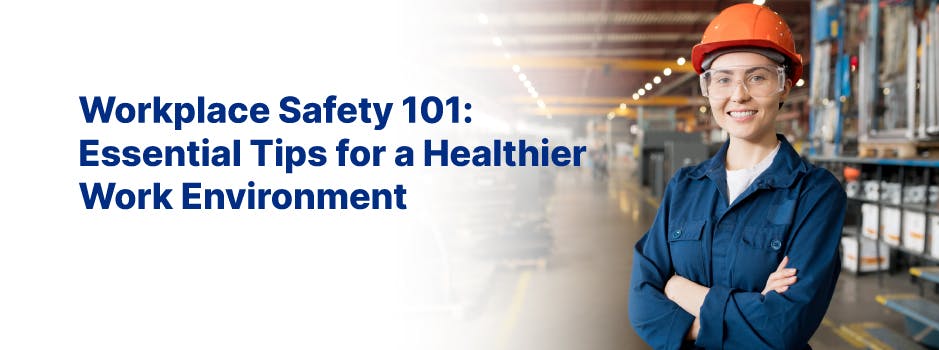Workplace safety is a critical aspect of any successful business, ensuring employee well-being and maximizing productivity. By understanding the basics of workplace safety and implementing practical strategies, employers can create a healthier work environment for all. This guide will cover essential tips for hazard identification, risk management, employee training, and fostering a culture of safety.
Hazard Identification and Risk Management
Conduct Regular Workplace Inspections
Routine workplace inspections help identify potential hazards and assess the effectiveness of existing safety measures. Inspections should be conducted by a designated safety officer or a team of employees knowledgeable about workplace processes and OSHA regulations.
Analyze Workplace Accident and Injury Data
Reviewing records of workplace accidents, injuries, and near misses can help identify trends and areas of concern. Employers can use this information to prioritize safety initiatives and implement corrective actions to prevent future incidents.
Implement a Hazard Reporting System
Encourage employees to report any observed hazards, near misses, or unsafe conditions. A well-implemented hazard reporting system helps identify potential risks and fosters a culture of open communication and shared responsibility for workplace safety.
Develop and Implement Risk Management Plans
Once hazards have been identified, employers should develop and implement risk management plans to eliminate or minimize risks. This process involves:
- Prioritizing hazards based on the severity and likelihood of harm
- Identifying and implementing appropriate control measures (e.g., engineering controls, administrative controls, personal protective equipment)
- Monitoring the effectiveness of control measures and making adjustments as necessary
Employee Training and Education
Provide Safety Orientation for New Employees
New employees should receive a comprehensive safety orientation that covers company policies and procedures, hazard communication, emergency response plans, and the proper use of personal protective equipment (PPE).
Offer Ongoing Safety Training
Regular safety training helps keep employees informed about new hazards, updated OSHA regulations, and best practices for maintaining a safe work environment. Training topics may include:
- Safe work practices for specific tasks and equipment
- Hazard communication and the Globally Harmonized System (GHS)
- Ergonomics and injury prevention
- Workplace violence and harassment prevention
Train Employees in Emergency Preparedness
Employees should be trained in emergency preparedness and response, including evacuation procedures, first aid and CPR, and the use of fire extinguishers and other emergency equipment.
Promote Employee Wellness
Encourage employees to prioritize their physical and mental well-being by offering wellness initiatives, such as stress management workshops, fitness classes, and healthy eating programs. A healthier workforce is more likely to be engaged, productive, and safe in the workplace.
Fostering a Culture of Safety
Establish a Safety Committee or Designate Safety Representatives
A safety committee or designated safety representatives can help promote a culture of safety by:
- Developing and implementing safety policies and procedures
- Conducting regular workplace inspections and hazard assessments
- Organizing safety training and awareness activities
Encourage Open Communication and Feedback
Create an environment where employees feel comfortable discussing safety concerns and providing feedback on safety initiatives. Regularly solicit employee input and involve them in the development and implementation of safety policies and procedures.
Recognize and Reward Safe Behavior
Recognize and reward employees who demonstrate a commitment to workplace safety and contribute to the overall well-being of the workplace. Examples of recognition and rewards may include:
- Publicly acknowledging employees' safety achievements
- Offering incentives or bonuses for meeting safety goals
- Hosting events or activities to celebrate safety milestones
Lead by Example
Management should set the tone for workplace safety by demonstrating a commitment to health and well-being. Leading by example includes:
- Prioritizing safety in decision-making and resource allocation
- Regularly communicating the importance of workplace safety to employees
- Actively participating in safety training and initiatives
Regularly Review and Update Safety Policies and Procedures
Workplace safety is an ongoing process that requires continuous improvement. Regularly review and update safety policies and procedures to address new hazards, evolving regulations, and changing workplace conditions.
Essential Tips for a Healthier Work Environment
Maintain a Clean and Organized Workplace
A clean and organized workplace reduces the risk of accidents and promotes a healthy work environment. Implement housekeeping procedures to ensure work areas are free from clutter, spills, and other hazards.
Promote Proper Ergonomics
Encourage employees to use proper ergonomics when performing tasks, such as adjusting their workstations for optimal posture, taking regular breaks to stretch and move, and using tools and equipment designed to minimize strain.
Implement a Workplace Violence and Harassment Prevention Program
Workplace violence and harassment can have severe consequences on employee health and safety. Develop a prevention program that includes a clear policy, reporting procedures, and employee training on recognizing and addressing potential issues.
Monitor and Control Environmental Hazards
Ensure a healthy work environment by monitoring and controlling potential environmental hazards, such as poor air quality, excessive noise, or extreme temperatures. Implement engineering controls or provide personal protective equipment (PPE) as needed to mitigate these risks.
Conclusion
Workplace safety is essential for the health and well-being of employees, as well as the overall success of a business. By implementing the strategies outlined in this guide, employers can create a healthier work environment that promotes employee safety, productivity, and satisfaction. Keep in mind that fostering a culture of safety is an ongoing process that requires the commitment and active participation of everyone in the workplace.



